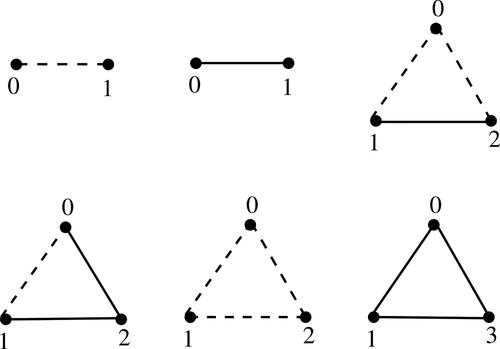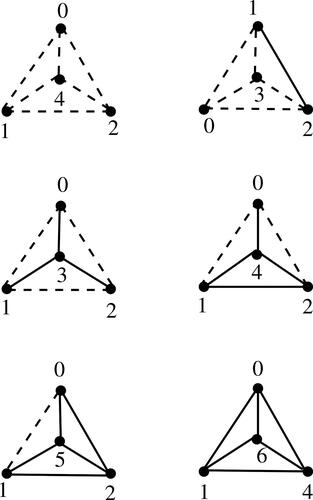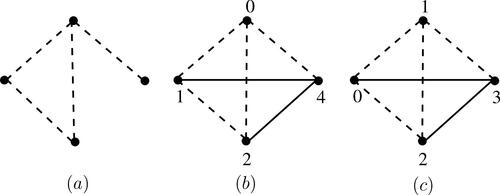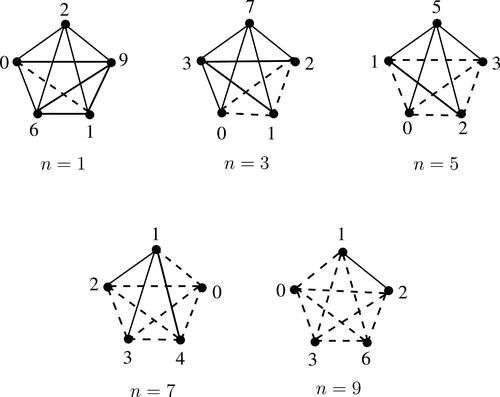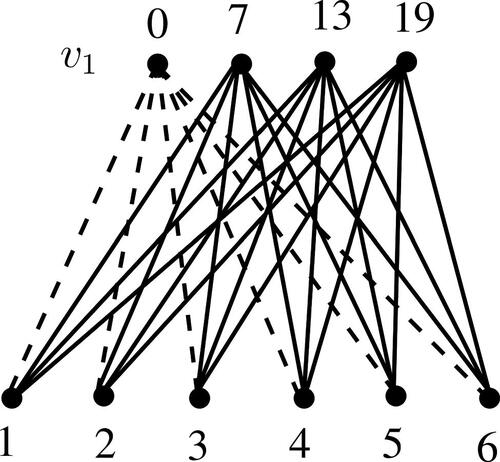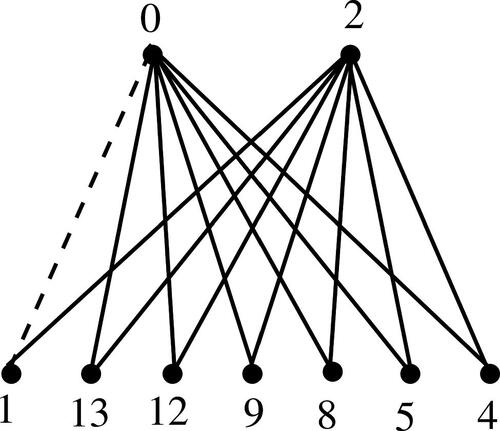 ?Mathematical formulae have been encoded as MathML and are displayed in this HTML version using MathJax in order to improve their display. Uncheck the box to turn MathJax off. This feature requires Javascript. Click on a formula to zoom.
?Mathematical formulae have been encoded as MathML and are displayed in this HTML version using MathJax in order to improve their display. Uncheck the box to turn MathJax off. This feature requires Javascript. Click on a formula to zoom.Abstract
Let be a signed graph of order p and size q. Let
and
Let
be an injective function and let
The function f is called an additively graceful labeling of S if and
In this paper we investigate the existence of additively graceful labeling of several classes of signed graphs.
1 Introduction
Unless mentioned otherwise, for standard terminology and notation in graph theory we follow West [Citation7] and those for signed graphs (or, ‘sigraphs’ in short) we refer the reader to Chartrand [Citation2] and Zaslavsky [Citation8, Citation9].
A (p, q)-sigraph is an ordered pair where
is a simple (p, q)-graph, called its underlying graph, and
is a function, called its signing function. Let
and
denote respectively the set of positive and the set of negative edges of S so that
is the edge set of S. Further, if
and
such that m + n = q then S is called a (p, m, n)-sigraph. An all-positive sigraph S is one in which
and an all-negative sigraph is one in which
. A sigraph is said to be homogeneous if it is either all-positive or all-negative, and heterogeneous otherwise.
An injection is said to be a graceful labeling if the induced edge function gf defined by
is a bijection from E to
. The graph which admits such a labeling is called a graceful graph (see [Citation4, Citation6]). Several classes of graceful and nongraceful graphs have been reported in the literature. For more details see Gallian [Citation3].
Let be a signed graph. Let
be an injection and let gf be defined on V by
If
and
then f is called a graceful labeling of S. A sigraph S which admits such a labeling is called a graceful sigraph [Citation4, Citation6].
Hegde [Citation5] introduced the notion of additively graceful graph as follows: A (p, q)-graph with
and
is said to be additively graceful if it admits a labeling
such that the edge induced labels defined by
are all distinct, and
is a bijection. He has characterized some additively graceful graphs, given a lower bound on number of edges of an additively graceful graph and some necessary or sufficient conditions for a graph to be additively graceful.
We extend this notion of additively graceful graphs to the realm of sigraphs as follows:
Definition 1.1.
Let be a signed graph of order p and size q. Let
and
Let
be an injective function and let
The function f is called an additively graceful labeling of S if and
Example 1.2.
gives examples of additively graceful sigraphs. In the figure, dashed lines are negative edges and solid lines are positive edges.
One can easily see that when n = 0, f is a graceful labeling of S, and when m = 0, f is an additively graceful labeling of S. We need the following theorems on graceful graphs and additively graceful graphs.
Theorem 1.3.
[Citation4, Citation6] The complete graph Kn of order n is graceful if and only if .
Theorem 1.4.
[Citation4, Citation6] If G is an Eulerian (p, q)-graph with then G is not graceful.
Theorem 1.5.
[Citation4] A necessary condition for a (p, q)-graph to be graceful is that it be possible to partition its vertex set
into two subsets Vo and Ve such that there are exactly
edges each of which joins a vertex of Vo with one of Ve.
Theorem 1.6.
[Citation5] If G is an additively graceful (p, q)-graph then and this bound is the best possible.
Theorem 1.7.
[Citation5] The complete graph Kp is additively graceful if and only if .
Theorem 1.8.
[Citation5] An additively graceful graph is either K2 or or has a triangle.
Theorem 1.9.
[Citation5] If an Eulerian (p, q)-graph G is additively graceful then .
Theorem 1.10.
[Citation5] A unicyclic graph G is additively graceful if and only if G is isomorphic to either C3 or to the graph obtained by joining a unique vertex to any one vertex of C3.
In this paper we present several basic results on additively graceful sigraphs.
2 Basic results
Theorem 2.1.
Let S be an additively graceful sigraph with labeling f. Then there exists a partition of V(G) into Vo and Ve such that and
where
and
are the number of positive and negative edges of S respectively each of which joins a vertex of Vo with one of Ve.
Proof.
Let and
. Therefore every edge receiving an odd label must join a vertex of Vo with one of Ve. Since the number of edges of S with odd positive labels is
and the number of edges of S with odd negative labels is
, it follows that
and
. □
Theorem 2.2.
Let S be a (p, m, n) additively graceful sigraph with labeling f. If n is odd, then and if n is even, then
and the bounds are sharp.
Proof.
Since the highest vertex label is , we have
Now we have the following two cases:
Case 1:
n is odd.
Then
Hence
Therefore
The bound is sharp for the following infinite family of graphs when n is odd. Let be a path of length q with one negative edge xv0. Assign x the label 0. When i is even, assign vi the label
and if i is odd vi is labeled
.
Case 2:
n is even.
Then
Hence
Therefore
When n is even, the bound is sharp for the following infinite family of graphs. Consider the path
of length q where the edges xy and yv0 are negative. Assign x and y the labels 1 and 0, respectively. For i even, assign vi the label
and for i odd, vi is labeled
.
The result follows from Case 1 and Case 2. □
Corollary 2.3.
If S is an all negative sigraph which admits an additively graceful labeling then .
Lemma 2.4.
If a sigraph S is additively graceful, then the sum of all edge labels of any circuit C in S is even.
Proof.
Let S be an additively graceful sigraph with an additively graceful labeling f. Let and
denote the positive and the negative sections of C respectively. For
, let
. Where
denote the vertices of the positive section Pi and
,
denote the vertices of the negative section Qi. Let
for
and
for
. Since C is a cycle, we have
.
The sum of the edge labels on Pi and Qi for is respectively,
and
Hence if T denotes the sum of the edge labels of the edges of C, then
Therefore T is even. □
We have the following result from [Citation4] as a corollary.
Corollary 2.5.
Let be a graph and
be any function. Let
for any edge uv of G. Then the sum of the edge labels of all the edges on any circuit of G is even.
Theorem 2.6.
The sigraph S obtained from the -signed cycle
by adding k positive pendent edges
is additively graceful.
Proof.
There are three possibilities for the number of negative edges n in Z3.
Case 1:
Define by
for i = 1, 2, 3 and
for
. This gives an additively graceful labeling of S.
Case 2:
we have three sub-cases.
Case 2.1:
The edges and
are negative.
Define by
for i = 1, 2, 3 and
for
. This gives an additively graceful labeling of S.
Case 2.2:
The edges and
are negative.
This sigraph is isomorphic to the one in Case 2.1 above and hence is additively graceful.
Case 2.3:
The edges and
are negative.
This sigraph is not additively graceful. If it were, then the vertices would necessarily be labeled with the labels 2,1,0 respectively or with labels 1,2,0, respectively. Hence edge label 2 cannot be obtained on any of the pendent edges.
Case 3:
Here also we have three sub-cases.
Case 3.1:
is the negative edge.
Define by
for i = 1, 2;
and
for
. This gives an additively graceful labeling of S.
Case 3.2:
is the negative edge.
Define by
for i = 1, 2;
and
for
. This gives an additively graceful labeling of S.
Case 3.3:
The edges is negative.
This sigraph is isomorphic to the one in Case 3.2 above and hence is additively graceful. □
Theorem 2.7.
Let S be an additively graceful sigraph and let H be the subgraph induced by the set of all negative edges of S. The connected component of H which contains the vertex labeled by 0 is either a star or contains a triangle.
Proof.
Let C be the connected component of H which contains the vertex labeled by 0. Suppose C does not contain a triangle. Let u be a vertex of C with label 0 and let v1 and v2 be vertices adjacent to u in C with labels 1 and 2, respectively. Since is not an edge in C, there exists a vertex v3 with label 3 adjacent to u in C. Similarly if 4 is an edge label in C, then since
is not adjacent in C, there exists a vertex v4 with label 4 adjacent to u in C. Also if 5 is an edge label of C, then since neither
nor
is an edge in C, there exists a vertex v5 labeled 5 adjacent to u in C. Proceeding in this manner, we get that C is a star. □
3 Some additively graceful sigraphs
In this section, we present some results on additively graceful labeling of sigraphs on complete graphs, complete bipartite graphs and Eulerian graphs.
Theorem 3.1.
Let S be a (p, m, n)-Eulerian sigraph. A necessary condition for S to be additively graceful is that .
Proof.
Let f be an additively graceful labeling of a (p, m, n)-Eulerian sigraph. Then the m positive edges are labeled as and n negative edges are labeled as
. Since sum of the edge labels along the Eulerian circuit is even, by Lemma 2.4, we have
Hence
. □
Corollary 3.2.
If a (k, m, n)-signed cycle is additively graceful, then
.
Corollary 3.3.
If the signed cycle is such that
, then Zk is not an additively graceful sigraph.
We have the following result from [Citation1, Citation4, Citation6] as a corollary.
Corollary 3.4.
If S is a graceful Eulerian all-positive (p, m)-sigraph, then .
We have the following result from [Citation5] as a corollary.
Corollary 3.5.
If S is an additively graceful Eulerian all-negative (p, n)-sigraph, then .
Theorem 3.6.
Let be a positive integer such that none of p, p–2, p–4 is a perfect square. Then no sigraph on Kp is additively graceful.
Proof.
Suppose there exists a sigraph S on Kp which is additively graceful. By Theorem 2.1, there exists a partition of the vertex set V(S) into two subsets Vo and Ve such that , a + b = p and
For different parities of m and n we have the following three cases:
Case 1:
m and n are odd.
In this case, we have
Hence
Now
Since a–b is an integer it follows that p–4 is a perfect square, which is a contradiction.
Case 2:
One of m and n is odd and the other is even.
Without loss of generality, we assume that m is even and n is odd. In this case, we have
Hence
Now
Since a–b is an integer it follows that p–2 is a perfect square, which is a contradiction.
Case 3:
m and n are even.
In this case, we have
Hence
Now
Since a–b is an integer it follows that p is a perfect square, which is a contradiction. □
Lemma 3.7.
All sigraphs on are additively graceful.
Proof.
The additively graceful labeling of all sigraphs on are shown in □
Lemma 3.8.
A (p, m, n)-sigraph S on K4 is additively graceful if and only if either n = 0 or the subgraph H induced by the set of all negative edges is isomorphic to K4, , K3, P3 or P2.
Proof.
If H is isomorphic to K4, , K3, P3 or P2, then the labeling of S is given in .
Conversely, suppose S is additively graceful. If n = 0, then there is nothing to prove. Hence we assume that n > 0. We claim that . Suppose n = 4. It follows from Theorem 2.7 that H is isomorphic to the graph given in . There are exactly two possible labelings which give the set of induced edge labels
for the negative edges in H and this labeling is given in . The set of induced positive edge labels is not equal to {1, 2}. Thus S is not additively graceful. Hence
. If n = 6, then H = K4 and if n = 5, then
. If n = 3, then it follows from Theorem 2.7 that
or K3. If
, then the centre of the star gets the label 0 and the 3 pendent vertices receive the labels 1, 2, 3. But in this case the set of labels of the positive edges is not equal to {1, 2, 3}. Hence, if n = 3, then H = K3. If n = 2, then it follows from Theorem 2.7 that H = P3. If n = 1, then H = P2. □
Theorem 3.9.
If a sigraph on Kp, where ; x odd is additively graceful then the number of negative edges is
even for
even or odd for
odd for
Proof.
Let S be an additively graceful sigraph on Kp. Then by Theorem 3.1, we have . Since
, substituting
; where
or
;
; we get for
Case 1:
hence,
therefore,
must be even. That is, n must be even.
Case 2:
hence,
The product of the first two terms is
, where
Therefore, we have
l being odd we conclude that n can be either even or odd.
Case 3:
hence,
Therefore,
must be even.
Hence, n must be odd. □
Example 3.10.
gives the additively graceful labelings for the sigraphs on K5 for 1, 3, 5, 7, 9. In fact, it can be easily verified that these are the only sigraphs on K5 which are additively graceful.
Theorem 3.11.
Let G be the complete bipartite graph with bipartition
and
. Let S be the sigraph obtained from G by assigning negative sign to all edges incident with v1 and positive sign to all other edges. Then S is additively graceful.
Proof.
Define by
for
and
for
. This gives an additively graceful labeling of S. □
Example 3.12.
gives additively graceful labeling of the sigraph on with 6 negative edges incident on a single vertex.
Theorem 3.13.
Let G be the complete bipartite graph with bipartition
and
Let S be the sigraph obtained from G by assigning positive sign to all but one edge. Then S is additively graceful.
Proof.
Let the negative edge be . Define
by
It can be easily verified that f is an additively graceful labeling of S. □
Example 3.14.
gives additively graceful labeling of the sigraph on with one negative edge.
Theorem 3.15.
Let G be a star with bipartition
and
. Let S be the sigraph obtained from G by assigning positive sign to all but one edge. Then S is additively graceful.
Proof.
Let the negative edge be uw1. Define by f(u) = 1,
and
It can be easily verified that f is an additively graceful labeling of S. □
4 Conclusion and scope
In this paper, we have extended the concept of additively graceful graphs to the realm of sigraphs. We have obtained some necessary or sufficient conditions for additively graceful sigraphs and some results on Eulerian sigraph, complete bipartite sigraphs and complete sigraphs have also been obtained. One can investigate other classes of additively graceful sigraphs or characterize additively graceful sigraphs.
Acknowledgments
The authors are thankful to the two anonymous referees for their helpful suggestions, which resulted in improvement in the paper.
References
- Acharya, M., Singh, T. (2004). Graceful signed graphs. Czech. Math. J. 54(129): 291–302.
- Chartrand, G. (1977). Graphs as Mathematical Models. Boston, MA: Prindle, Weber and Schmidt, Inc.
- Gallian, J. A. (2021). A dynamic survey of graph labeling. Electron. J. Combin. # DS6: 1–43.
- Golomb, S. W. (1972). How to number a graph. In: Read, R. C., ed. Graph Theory and Computing. New York: Academic Press, pp. 23–37.
- Hegde, S. M. (1989). Additively graceful graphs. Nat. Acad. Sci. Lett. 12(11): 387–390.
- Rosa, A., On certain valuations of the vertices of a graph. In: Rosentiehl, P., ed. Theory of Graphs, International Symposium, Rome, 1966. New York and Dunod, Paris: Gordon and Breach, pp. 349–355.
- West, D. B. (1999). Introduction to Graph Theory. Delhi: Prentice-Hall India.
- Zaslavsky, T. (1982). Signed graphs. Discrete Appl. Math. 4(1): 47–74.
- Zaslavsky, T. (2005). A mathematical bibliography of signed and gain graphs and allied areas. Electron. J. Combin. DS #6: 1–148.


